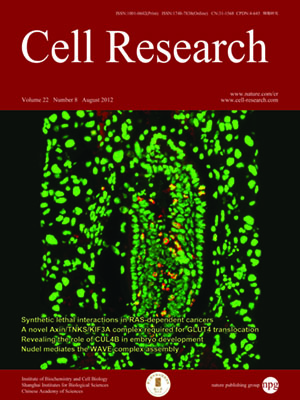
Volume 22, No 8, Aug 2012
ISSN: 1001-0602
EISSN: 1748-7838 2018
impact factor 17.848*
(Clarivate Analytics, 2019)
Volume 22 Issue 8, August 2012: 1258-1269
ORIGINAL ARTICLES
Essential role of the CUL4B ubiquitin ligase in extra-embryonic tissue development during mouse embryogenesis
Liren Liu1, Yan Yin2, Yuewei Li1, Lisa Prevedel1, Elizabeth H Lacy3, Liang Ma2 and Pengbo Zhou1
1Department of Pathology and Laboratory Medicine, Weill Cornell Medical College and Weill Graduate School of Medical Sciences of Cornell University, New York, NY 10065, USA
2Division of Dermatology, Washington University School of Medicine, St. Louis, MO 63110, USA
3Developmental Biology Program, Memorial Sloan-Kettering Cancer Center, New York, NY 10065, USA
Correspondence: Pengbo Zhou,(pez2001@med.cornell.edu)
Mutations of the
CUL4B ubiquitin ligase gene are causally linked to syndromic X-linked mental retardation (XLMR). However, the pathogenic role of CUL4B mutations in neuronal and developmental defects is not understood. We have generated mice with targeted disruption of
Cul4b, and observed embryonic lethality with pronounced growth inhibition and increased apoptosis in extra-embryonic tissues.
Cul4b, but not its paralog
Cul4a, is expressed at high levels in extra-embryonic tissues post implantation. Silencing of CUL4B expression in an extra-embryonic cell line resulted in the robust accumulation of the CUL4 substrate p21
Cip1/WAF and G2/M cell cycle arrest, which could be partially rescued by silencing of
p21Cip1/WAF. Epiblast-specific deletion of
Cul4b prevented embryonic lethality and gave rise to viable
Cul4b null mice. Therefore, while dispensable in the embryo proper,
Cul4b performs an essential developmental role in the extra-embryonic tissues. Our study offers a strategy to generate viable
Cul4b-deficient mice to model the potential neuronal and behavioral deficiencies of human CUL4B XLMR patients.
Cell Research (2012) 22:1258-1269. doi:10.1038/cr.2012.48; published online 27 March 2012
FULL TEXT | PDF
Browse 2390


